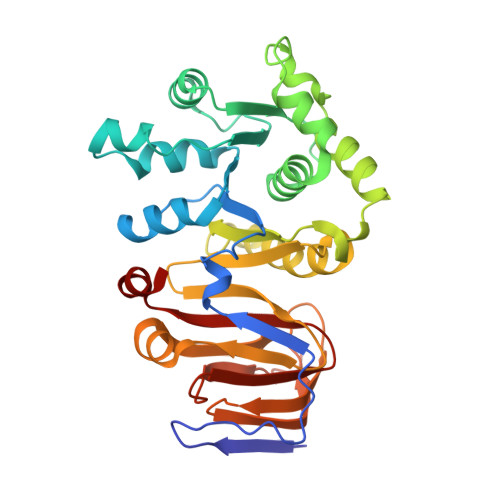The crystal structure of yeast thiamin pyrophosphokinase.
Baker, L.J., Dorocke, J.A., Harris, R.A., Timm, D.E.(2001) Structure 9: 539-546
- PubMed: 11435118
- DOI: https://doi.org/10.1016/s0969-2126(01)00615-3
- Primary Citation of Related Structures:
1IG0 - PubMed Abstract:
Thiamin pyrophosphokinase (TPK) catalyzes the transfer of a pyrophosphate group from ATP to vitamin B1 (thiamin) to form the coenzyme thiamin pyrophosphate (TPP). Thus, TPK is important for the formation of a coenzyme required for central metabolic functions. TPK has no sequence homologs in the PDB and functions by an unknown mechanism. The TPK structure has been determined as a significant step toward elucidating its catalytic action. The crystal structure of Saccharomyces cerevisiae TPK complexed with thiamin has been determined at 1.8 A resolution. TPK is a homodimer, and each subunit consists of two domains. One domain resembles a Rossman fold with four alpha helices on each side of a 6 strand parallel beta sheet. The other domain has one 4 strand and one 6 strand antiparallel beta sheet, which form a flattened sandwich structure containing a jelly-roll topology. The active site is located in a cleft at the dimer interface and is formed from residues from domains of both subunits. The TPK dimer contains two compound active sites at the subunit interface. The structure of TPK with one substrate bound identifies the location of the thiamin binding site and probable catalytic residues. The structure also suggests a likely binding site for ATP. These findings are further supported by TPK sequence homologies. Although possessing no significant sequence homology with other pyrophospokinases, thiamin pyrophosphokinase may operate by a mechanism of pyrophosphoryl transfer similar to those described for pyrophosphokinases functioning in nucleotide biosynthesis.
Organizational Affiliation:
Department of Biochemistry and Molecular Biology, Indiana University School of Medicine, Indianapolis, IN 46202, USA.















